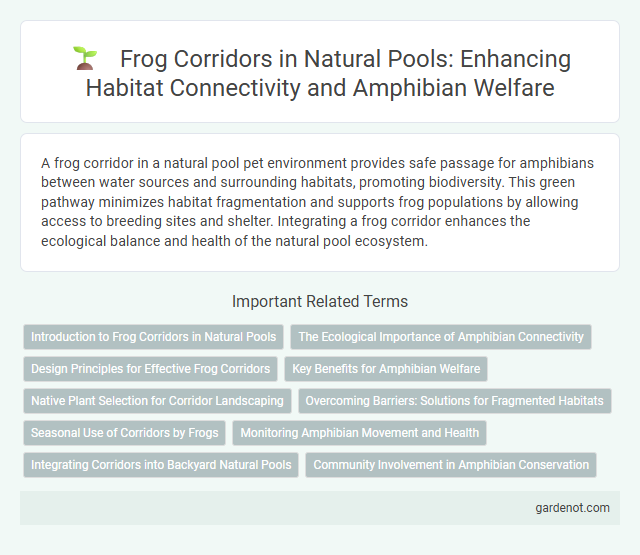A frog corridor in a natural pool pet environment provides safe passage for amphibians between water sources and surrounding habitats, promoting biodiversity. This green pathway minimizes habitat fragmentation and supports frog populations by allowing access to breeding sites and shelter. Integrating a frog corridor enhances the ecological balance and health of the natural pool ecosystem.
Introduction to Frog Corridors in Natural Pools
Frog corridors in natural pools serve as crucial pathways that connect aquatic habitats, facilitating safe movement and breeding for amphibian populations. These corridors reduce habitat fragmentation by linking isolated ponds and wetlands, promoting genetic diversity and population stability. Incorporating frog corridors into natural pool designs enhances local biodiversity and supports ecological balance.
The Ecological Importance of Amphibian Connectivity
Frog corridors play a critical role in maintaining amphibian connectivity by facilitating safe migration between aquatic and terrestrial habitats essential for breeding, foraging, and shelter. These natural pathways help preserve genetic diversity, reduce population fragmentation, and enhance the resilience of amphibian species against environmental changes. Protecting and restoring frog corridors within natural pool ecosystems supports broader biodiversity and ecological balance.
Design Principles for Effective Frog Corridors
Effective frog corridors prioritize connectivity by linking breeding ponds with surrounding habitats, ensuring safe migration routes. Vegetation structure is essential, providing shelter and moisture to support amphibian movement and reduce predation risk. Incorporating natural materials and maintaining humidity levels enhances corridor suitability for diverse frog species.
Key Benefits for Amphibian Welfare
Frog corridors provide essential safe passages connecting breeding ponds and terrestrial habitats, reducing road mortality and habitat fragmentation for amphibians. These natural pathways enhance genetic diversity by facilitating migration and promoting population stability. Ensuring connectivity within a natural pool ecosystem supports amphibian welfare by maintaining healthy, resilient populations in their native environment.
Native Plant Selection for Corridor Landscaping
Native plant selection for frog corridors in natural pool landscaping enhances habitat connectivity by providing essential shelter and breeding grounds. Species such as pickerelweed, arrowhead, and blue flag iris support local amphibian populations by offering food sources and moisture retention. Incorporating diverse native vegetation ensures ecological balance and promotes frog migration between aquatic habitats.
Overcoming Barriers: Solutions for Fragmented Habitats
Natural pools with integrated frog corridors effectively address fragmented habitats by creating continuous, safe passageways for amphibians. These corridors overcome physical barriers such as roads and urban development, facilitating gene flow and reducing population isolation. Implementing vegetation buffers and strategically placed water features promotes connectivity and biodiversity within ecosystems.
Seasonal Use of Corridors by Frogs
Frogs utilize natural pool corridors seasonally, migrating primarily during spring and autumn for breeding and overwintering. These corridors facilitate safe passage between aquatic habitats and terrestrial breeding grounds, increasing population connectivity and genetic diversity. Maintaining intact vegetation and moisture levels along these routes is crucial for amphibian survival and successful reproduction.
Monitoring Amphibian Movement and Health
Frog corridors enhance natural pool ecosystems by facilitating amphibian movement, critical for breeding and genetic diversity. Monitoring amphibian health within these corridors reveals population trends and potential environmental threats. Data collected informs conservation strategies, ensuring sustainable habitats and robust amphibian populations.
Integrating Corridors into Backyard Natural Pools
Integrating frog corridors into backyard natural pools enhances amphibian habitat connectivity, promoting biodiversity and ecological balance. These corridors provide safe passage for frogs between breeding sites and foraging areas, reducing road mortality and increasing population resilience. By incorporating native vegetation and shallow water zones, the corridors support amphibian life cycles and improve water quality in the natural pool ecosystem.
Community Involvement in Amphibian Conservation
Frog corridors are vital wildlife pathways that connect fragmented habitats, enabling amphibians to migrate safely between breeding and feeding sites. Community involvement plays a crucial role in maintaining these corridors by monitoring populations, reducing habitat disturbances, and promoting native vegetation planting. Local engagement fosters environmental stewardship, enhances biodiversity, and supports long-term conservation of amphibian species.
Frog corridor Infographic

 gardenot.com
gardenot.com